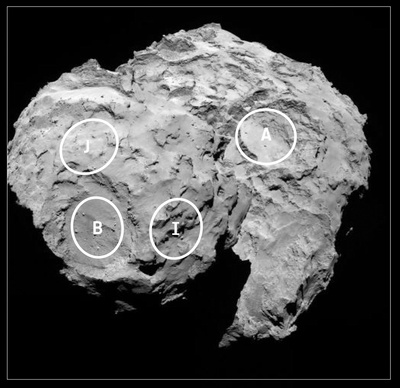Rosetta: Landing site search narrows
Choosing the right landing site is a complex process. It must balance the technical needs of the orbiter and lander during all phases of the separation, descent and landing, and during operations on the surface, with the scientific requirements of the 10 instruments on board Philae. A key issue is that uncertainties in navigating the orbiter close to the comet mean that it is possible to specify any given landing zone only in terms of an ellipse - covering up to six-tenths of a square mile (one square kilometer) - within which Philae might land.
"This is the first time landing sites on a comet have been considered," said Stephan Ulamec, Philae Lander Manager at the German Aerospace Center, Cologne, Germany. "The candidate sites that we want to follow up for further analysis are thought to be technically feasible on the basis of a preliminary analysis of flight dynamics and other key issues - for example, they all provide at least six hours of daylight per comet rotation and offer some flat terrain. Of course, every site has the potential for unique scientific discoveries."
For each possible zone, important questions must be asked: Will the lander be able to maintain regular communications with Rosetta? How common are surface hazards such as large boulders, deep crevasses or steep slopes? Is there sufficient illumination for scientific operations and enough sunlight to recharge the lander's batteries beyond its initial 64-hour lifetime without causing overheating?
The potential landing sites were assigned a letter from an original pre-selection of 10 possible sites, which does not signify any ranking. Three sites (B, I and J) are located on the smaller of the two lobes of the comet and two sites (A and C) are located on the larger lobe.
"The process of selecting a landing site is extremely complex and dynamic; as we get closer to the comet, we will see more and more details, which will influence the final decision on where and when we can land," said Fred Jansen, Rosetta's mission manager from the European Space Agency's Science and Technology Centre in Noordwijk, The Netherlands. "We had to complete our preliminary analysis on candidate sites very quickly after arriving at the comet, and now we have just a few more weeks to determine the primary site. The clock is ticking and we now have to meet the challenge to pick the best possible landing site."
The next step in preparation for landing operations is a comprehensive analysis of each of the candidate sites, to determine possible orbital and operational strategies that could be used for Rosetta to deliver the lander to any of them. At the same time, Rosetta will move to within 31 miles (50 kilometers) of the comet, allowing a more detailed study of the proposed landing sites. By September 14, the five candidate sites will have been assessed and ranked, leading to the selection of a primary landing site. A fully detailed strategy for the landing operations at the selected site will be developed, along with a backup.
The landing of Philae is expected to take place in mid-November when the comet is about 280 million miles (450 million kilometers) from the sun. This will be before activity on the comet reaches levels that might jeopardize the safe and accurate deployment of Philae to the comet's surface, and before surface material is modified by this cometary activity.
Launched in March 2004, Rosetta was reactivated in January 2014 after a record 957 days in hibernation. Composed of an orbiter and lander, Rosetta's objectives since arriving at comet 67P/Churyumov-Gerasimenko earlier this month are to study the celestial object up close in unprecedented detail, prepare for landing a probe on the comet's nucleus in November, and track its changes through 2015, as it sweeps past the sun.
Comets are time capsules containing primitive material left over from the epoch when the sun and its planets formed. Rosetta's lander will obtain the first images taken from a comet's surface and will provide comprehensive analysis of the comet's possible primordial composition by drilling into the surface. Rosetta also will be the first spacecraft to witness at close proximity how a comet changes as it is subjected to the increasing intensity of the sun's radiation. Observations will help scientists learn more about the origin and evolution of our solar system and the role comets may have played in seeding Earth with water, and perhaps even life.
The scientific imaging system, OSIRIS, was built by a consortium led by the Max Planck Institute for Solar System Research (Germany) in collaboration with Center of Studies and Activities for Space, University of Padua (Italy), the Astrophysical Laboratory of Marseille (France), the Institute of Astrophysics of Andalusia, CSIC (Spain), the Scientific Support Office of the European Space Agency (Netherlands), the National Institute for Aerospace Technology (Spain), the Technical University of Madrid (Spain), the Department of Physics and Astronomy of Uppsala University (Sweden) and the Institute of Computer and Network Engineering of the TU Braunschweig (Germany). OSIRIS was financially supported by the national funding agencies of Germany (DLR), France (CNES), Italy (ASI), Spain, and Sweden and the ESA Technical Directorate.
Rosetta is an ESA mission with contributions from its member states and NASA. Rosetta's Philae lander is provided by a consortium led by the German Aerospace Center, Cologne; Max Planck Institute for Solar System Research, Gottingen; French National Space Agency, Paris; and the Italian Space Agency, Rome. NASA's Jet Propulsion Laboratory in Pasadena, California, a division of the California Institute of Technology, manages the U.S. participation in the Rosetta mission for NASA's Science Mission Directorate in Washington.
For more information on the U.S. instruments aboard Rosetta, visit: http://rosetta.jpl.nasa.gov
More information about Rosetta is available at: http://www.esa.int/rosetta
